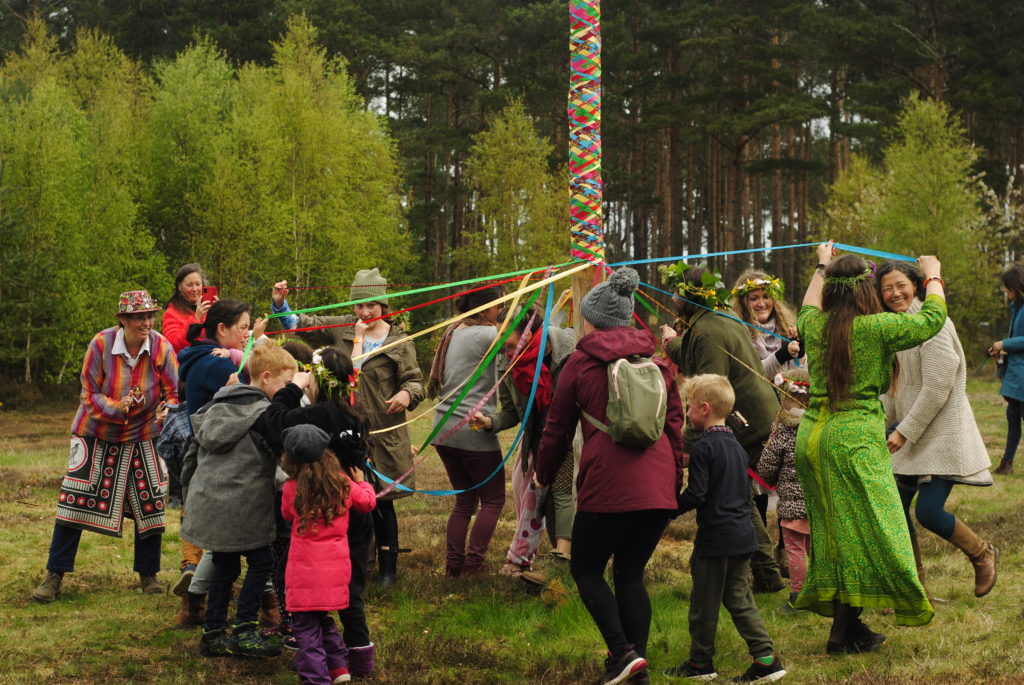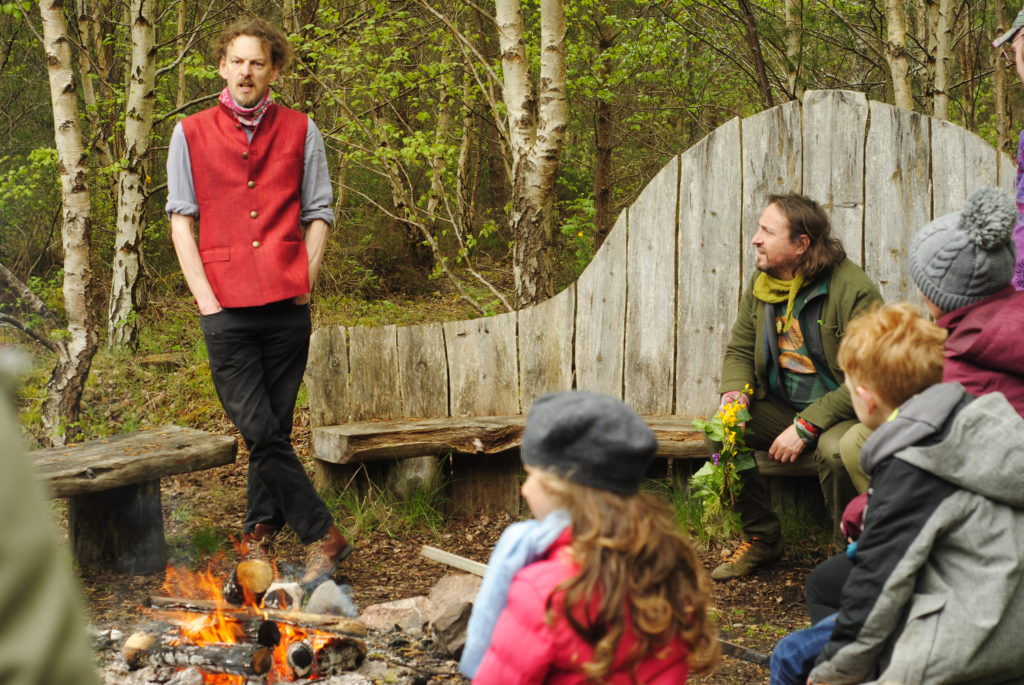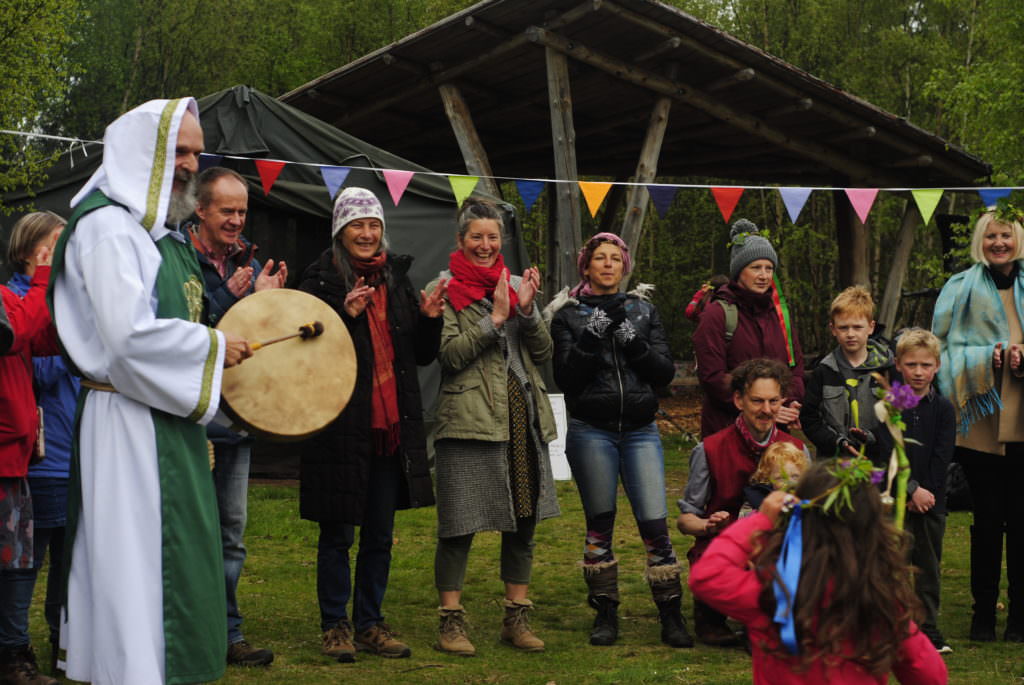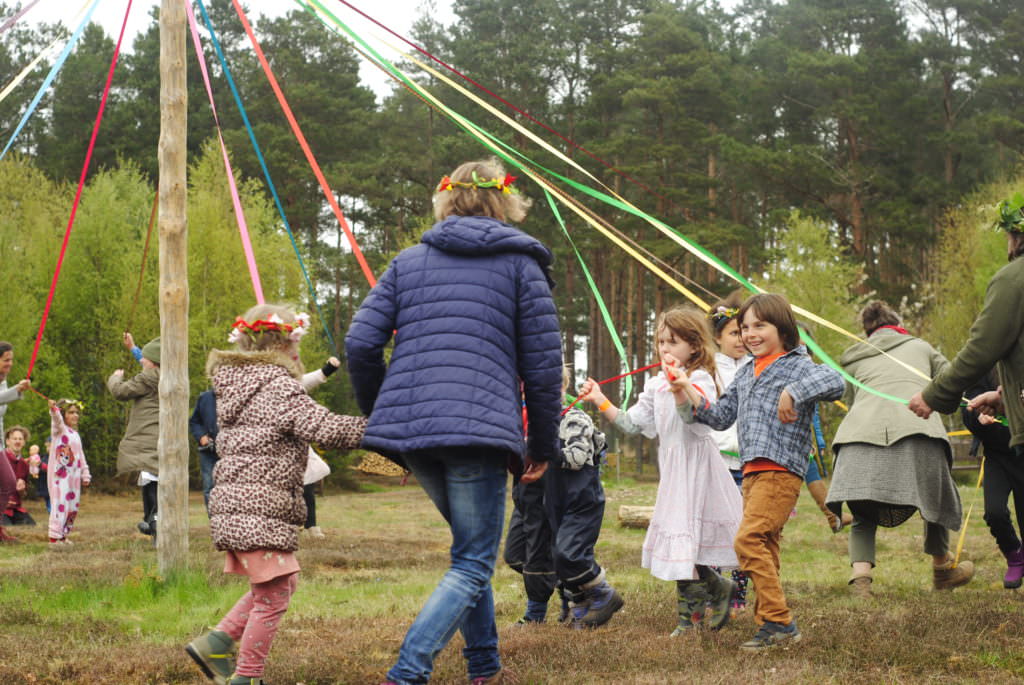by Linde de Vroey
On the first of May, I had the chance to join the Findhorn community when they came together at the Ceremonial Burial Ground in Wilkies Wood to celebrate May Day. I was immediately struck by the brightness of all the colors: the beautiful yellow, white and pink flowers in the crowns, the dark green and gold embroidery of the ceremonial costume, the bright green color of the grass, and the May pole with shiny ribbons in every color of the rainbow. Though the weather wasn’t as bright as the flowers, the people who joined surely were, and there was a happy atmosphere in the air. After all, we were here to celebrate spring!

We started the day by weaving crowns of willow, ivy, flowers and ribbons – a truly enjoyable and creative activity, and of course everyone needed to look their best for the actual celebration. When all the children (and lots of adults) had their crowns ready, we gathered together in a circle for the ceremony. Draeyk guided us all in a beautiful moment of reflection, to thank the land and wish for peace. And then it was time for the highlight of the day: the dance around the MayPole! I had never seen a May day dance before, and I was mesmerized by all those beautiful ribbons almost magically weaving a pattern together, just as a result of the dancing. As I stood there, singing and clapping and watching, I found it truly beautiful to see this age-old dance re-enacted; not as some old relic of the past, but as a very living moment – and as a lot of fun too! It reminded me of something I read by the Potawatomi writer Robin Wall Kimmerer, about the importance of sustaining ceremony as a community:
“Ceremony focuses attention so that attention becomes intention. If you stand together and profess a thing before your community, it holds you accountable. Ceremonies transcend the boundaries of the individual and resonate beyond the human realm. These acts of reverence are powerfully pragmatic. These are ceremonies that magnify life.”

On May Day in Findhorn, I could see these acts in action. By honoring tradition, we honor the history of a place, the people and beings who came before us and who cared for this land, so that we could now make a living here. By giving thanks to the land, we sustain our relationship to the land. By dancing together, we weave a community with the people and the place and all beings that live here. But the truly wonderful thing is that by celebrating together, caring together, dancing together, we don’t even have to think about it. We live it.

About the Author:
I am a philosopher and a PhD researcher at the University of Antwerp, Belgium. My research focuses on the intersection between ecological restoration, rewilding and cultural heritage. I am very interested in place-based and community-guided approaches to restoration; and in the role that cultural tradition, stories, language, ceremony and history can play in restoring the relationship between people and the natural landscape. I first came to the Park Ecovillage, Findhorn last April in light of my research project. There I encountered a unique place where the community has carried out pioneering and inspiring work, not only restoring the land, but also restoring and sustaining an intimate relationship between the community and the land.


















May Day Celebration in the Findhorn Hinterland
by Linde de Vroey
On the first of May, I had the chance to join the Findhorn community when they came together at the Ceremonial Burial Ground in Wilkies Wood to celebrate May Day. I was immediately struck by the brightness of all the colors: the beautiful yellow, white and pink flowers in the crowns, the dark green and gold embroidery of the ceremonial costume, the bright green color of the grass, and the May pole with shiny ribbons in every color of the rainbow. Though the weather wasn’t as bright as the flowers, the people who joined surely were, and there was a happy atmosphere in the air. After all, we were here to celebrate spring!
We started the day by weaving crowns of willow, ivy, flowers and ribbons – a truly enjoyable and creative activity, and of course everyone needed to look their best for the actual celebration. When all the children (and lots of adults) had their crowns ready, we gathered together in a circle for the ceremony. Draeyk guided us all in a beautiful moment of reflection, to thank the land and wish for peace. And then it was time for the highlight of the day: the dance around the MayPole! I had never seen a May day dance before, and I was mesmerized by all those beautiful ribbons almost magically weaving a pattern together, just as a result of the dancing. As I stood there, singing and clapping and watching, I found it truly beautiful to see this age-old dance re-enacted; not as some old relic of the past, but as a very living moment – and as a lot of fun too! It reminded me of something I read by the Potawatomi writer Robin Wall Kimmerer, about the importance of sustaining ceremony as a community:
“Ceremony focuses attention so that attention becomes intention. If you stand together and profess a thing before your community, it holds you accountable. Ceremonies transcend the boundaries of the individual and resonate beyond the human realm. These acts of reverence are powerfully pragmatic. These are ceremonies that magnify life.”
On May Day in Findhorn, I could see these acts in action. By honoring tradition, we honor the history of a place, the people and beings who came before us and who cared for this land, so that we could now make a living here. By giving thanks to the land, we sustain our relationship to the land. By dancing together, we weave a community with the people and the place and all beings that live here. But the truly wonderful thing is that by celebrating together, caring together, dancing together, we don’t even have to think about it. We live it.
About the Author:
I am a philosopher and a PhD researcher at the University of Antwerp, Belgium. My research focuses on the intersection between ecological restoration, rewilding and cultural heritage. I am very interested in place-based and community-guided approaches to restoration; and in the role that cultural tradition, stories, language, ceremony and history can play in restoring the relationship between people and the natural landscape. I first came to the Park Ecovillage, Findhorn last April in light of my research project. There I encountered a unique place where the community has carried out pioneering and inspiring work, not only restoring the land, but also restoring and sustaining an intimate relationship between the community and the land.